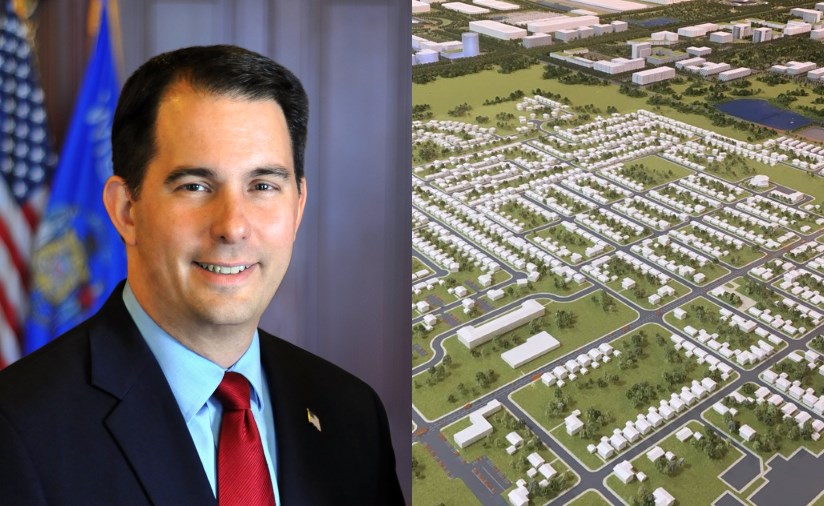Foxconn Project in “Chaos”
Foxconn workers, insiders say Racine project is failing in Bloomberg story.
Reporter Austin Carr interviewed 49 people familiar with Foxconn’s project in Racine County, “including more than a dozen current and former employees,” and the resulting story for Bloomberg is revealing. While the general picture is similar to Urban Milwaukee’s story of last week, the specific details are often stunning, suggesting this deal was fanciful and doomed to fail from the start, yet officials in the administration of then Governor Scott Walker were too gullible to see this.
As experts suggested when Foxconn CEO Terry Gou first pitched the deal, the company, mostly based in China, was looking to hedge its bets in anticipation of tariffs on Chinese-made goods. “The biggest challenge facing Foxconn is a U.S.-China trade war,” Gou once said at an annual shareholders’ meeting. “Generating goodwill with Trump and top Republican leaders such as… then-Speaker of the House Paul Ryan, whose district included Mount Pleasant (where the Foxconn plant was to be located), seemed like a hedge that might insulate Foxconn from tariffs or other unpleasantness between Trump and Beijing,” Carr writes.
So Foxconn contacted the Trump administration and “told the White House it wanted to create thousands of jobs somewhere in North America, and based on a recent trip he’d taken with [Reince] Priebus, who’d grown up in the state, Trump suggested Wisconsin,” Carr writes.
And so in April 2017 Jared Kushner’s Office of American Innovation at the White House called the Wisconsin Economic Development Corporation, the state jobs agency that would oversee the Foxconn deal, about a potential $10 billion deal.
Gou and Foxconn had a documented record of creating factories with dreadful conditions, that exploited workers and created massive pollution problems — and a reputation for walking out on deals after making extravagant promises that never materialized.
But “Wisconsin officials apparently didn’t consider Gou’s track record problematic,” Carr writes. “Instead, they describe the billionaire, who charmed them with stories of his early days selling TV parts in the Midwest, as almost philanthropic. ‘My impression of him was, what a nice person,” says Scott Neitzel, who led negotiations for the Walker administration. ‘An extremely genuine, down-to-earth tycoon.’ When asked if the state looked at Foxconn’s history, WEDC Chief Executive Officer Mark Hogan says, ‘We didn’t spend a lot of time on that because, in the end, we got to know these people so well.’”
Gou, the man they got to know so well is “a demanding leader notorious for punishing underperforming managers by making them stand for long periods during meetings and an aggressive negotiator who “once described Genghis Khan as a personal hero,” Carr writes. “Over four decades, he transformed Foxconn into the world’s largest contract manufacturer of electronics partly by scrupulously securing tax breaks and subsidies. ‘In meetings, it’s Terry’s way or no way,’ says a former company executive… ‘If you get local officials in a room with him, I can tell you Terry is going to win.’
All past reporting suggests Walker simply agreed to the terms Gou proposed. Hogan told Carr that Foxconn estimated a 30 percent cost difference manufacturing in the U.S., which would need to be subsidized by Wisconsin. Hogan acknowledged “the subsidy numbers grew ‘staggering’ but says Foxconn won’t get those incentives without delivering the promised number of jobs.”
Gou soon got local officials in Racine to offer more subsidies. Now the question was: what would he produce at this Racine County plant?
“Soon after signing its contract with the state, Foxconn brought in local staff and began testing initial manufacturing in the leased, 155,000-square-foot building… slightly north of the (Foxconn) campus,” Carr writes.”The Experimental Training Center, as it’s called, was designed to prep workers and pilot LCD assembly.” The company set up machinery and had production going by early 2018, some ten months before Walker needed to win reelection.
But the transition from cheap labor countries like China and Mexico to America wasn’t going well. “Multiple sources say Foxconn higher-ups kept to themselves, production goals were in constant flux, and equipment seemed dated,” Carr writes. “The company tried and failed to produce its own LCD materials at scale in Wisconsin.” Instead, “They were shipped from a Foxconn factory in Tijuana. The Wisconsin plant was only handling the last steps of assembly, and some TV displays were still labeled ‘Made in Mexico.’”
“Pay at the factory started at about $14 an hour with no benefits, much less than the $23 average Foxconn promised,” Carr reports “Insiders describe a chaotic environment with ever-changing goals…A Foxconn manager at the factory, which then had only about 60 people working there, abruptly called about 15 of them—all interns —into a room to say they should seek other jobs because there wasn’t enough work to hire them full time, according to multiple people present. Two sources recall the manager telling the group, cryptically, that there were forces outside the company’s control affecting the Wisconsin project.”
By June 2018, the company revealed that it was changing its plans and wouldn’t be building a Gen 10.5 plant to produce large TV screens (10 foot by 11 foot) in its Wisconsin plant, but instead would be building a Gen 6 plant producing roughly 5 foot by 6 foot glass panels. At the time the presumed reason was that the glass manufacturer Corning had declined to co-locate at the Foxconn campus unless it, too, got a state subsidy and the Walker administration declined. But Carr’s reporting suggest Foxconn’s problems starting up manufacturing here might have been a factor.
The switch in plans had to concern the Walker administration given one expert’s review of the situation, that a $10 billion investment made sense for a Gen 10.5 plant, but a Gen 6 plant would require only a $2 billion to $3 billion investment. As Carr writes, “state staffers informally discussed whether the switch to a Gen 6 plant constituted a breach of contract, because the agreement specifically required a Gen 10.5.”
But by August, Foxconn admitted that even the Gen 6 plant, if built, wouldn’t be producing TV products for long and any manufacturing that was done would mostly use robots.
The company’s operation in Racine County had quickly moved toward robots, Carr writes. “The robots the company kept adding made many production positions seem likely to become obsolete. Former workers say they felt expendable, and that Foxconn lured in temps with the vague promise of future full-time positions that often didn’t materialize.”
As Foxconn began to walk back its original promises, with Walker in the midst of a hard-fought campaign, some good news was badly needed. “Following a similar playbook as it did in India and Brazil, the company in August announced a $100 million joint venture fund and said it’s building R&D centers around Wisconsin, including in Eau Claire and Green Bay. Nobody has cogently explained what these centers will do.”
Company officials and Walker contended these satellite centers were needed to recruit graduates of UW-Eau Claire and UW-Green Bay to work for Foxconn, without explaining why they couldn’t simply have them apply for jobs in Racine.
After Foxonn spokesperson Louis Woo’s August announcement that “we are not really interested in television” and that the company would be creating a knowledge-based operation in Racine County, it was far from clear what this meant.
Explanations from Alan Yeung, Foxconn’s director of U.S. strategic initiatives, didn’t help. He “took the stage at the Future Wisconsin Summit in a packed Madison convention center,” Carr reports, and “What followed were 39 minutes of buzzwords. Among the projects he said Foxconn might pursue in Wisconsin were 8K video streaming, cloud computing, 3D printing, 5G wireless networks, smart cities, the sharing economy, artificial intelligence, facial recognition, the internet of things, renewable energy, autonomous vehicles, and digital microsurgery.”
All pretty vague and not necessarily something that would require Wisconsin workers. Just before the election, the Wall Street Journal reported that Foxconn was considering bringing engineers to Wisconsin from China. “Foxconn denied the story,” Carr reports, “but state officials realized there was nothing in the contract to stop that.”
Nor could they prevent Foxonn from hiring workers from Illinois, who would not be paying taxes to Wisconsin, reducing the expected payback to the state. “The company also appeared to be bringing in foreign staff,” Carr reports. “While Foxconn says it’s only used workers with H-1B visas in Wisconsin on a short-term basis, a Foxconn H-1B filing viewed by Bloomberg Businessweek lists a manufacturing engineer hired to work at the Wisconsin facility through September 2021.”
The WEDC has recently said it will tighten its procedures to prevent the company from getting subsidies from non-state employees, but this will make the deal less attractive for Foxconn, which was already questioning whether it made sense to continue with “Flying Eagle,” the name the company gave the Wisconsin plant.
“Some company leaders were losing faith in Flying Eagle, which they saw as an expensive drain on resources needed elsewhere,” Carr reports. “A lot of the internal perception became, ‘This is a nightmare. This is going to be horrible for Foxconn’s brand.’ ”
But even if Foxconn stays, its operation will never come close to what was originally promised. “Almost every current and former Foxconn employee interviewed for this story predicted there will never be anywhere near 13,000 workers in Wisconn Valley. As of press time, there were only 122 job listings on the company’s website, many at least five months old… Foxconn has dismissed a number of Wisconsin employees in the past several months, and managers there have discussed significant budget cuts.”
Even as first proposed there was little chance the state would ever recoup the promised subsidy of $4.1 billion from state and local government. “There’s no way this will ever pay itself off,” Tim Bartik, a senior economist at the W.E. Upjohn Institute for Employment Research, told Bloomberg, noting that “Foxconn’s incentives are more than 10 times greater than typical government aid packages of its stripe.”
With what appears to be a drastically reduced plan by Foxconn, the total promised subsidy will drop significantly. But the upfront costs for local governments to buy land and create infrastructure for the Foxconn campus, which top off at $783 million (but could be less with a smaller plant) and the costs for the state of $120 million (or more) for new and improved roads and $150 in sales tax exemptions, when added to subsidies for any actual Foxconn capital spending and employees hired, will likely make the per-worker subsidy even higher than Bartik estimates.
Even Noah Williams, an economics professor from UW-Madison who sought a job from Walker and wrote a paper applauding the Foxconn deal, told Carr that in light of all these changes, the state ought to redo the math.
While campaigning for office Gov. Tony Evers called Foxconn “a horrible deal.” He may have been understating the situation.
If you think stories like this are important, become a member of Urban Milwaukee and help support real independent journalism. Plus you get some cool added benefits, all detailed here.
More about the Foxconn Facility
- Foxconn Acquires 20 More Acres in Mount Pleasant, But For What? - Joe Schulz - Jan 7th, 2025
- Murphy’s Law: What Are Foxconn’s Employees Doing? - Bruce Murphy - Dec 17th, 2024
- With 1,114 Employees, Foxconn Earns $9 Million in Tax Credits - Joe Schulz - Dec 13th, 2024
- Mount Pleasant, Racine in Legal Battle Over Water After Foxconn Failure - Evan Casey - Sep 18th, 2024
- Biden Hails ‘Transformative’ Microsoft Project in Mount Pleasant - Sophie Bolich - May 8th, 2024
- Microsoft’s Wisconsin Data Center Now A $3.3 Billion Project - Jeramey Jannene - May 8th, 2024
- We Energies Will Spend $335 Million on Microsoft Development - Evan Casey - Mar 6th, 2024
- Foxconn Will Get State Subsidy For 2022 - Joe Schulz - Dec 11th, 2023
- Mount Pleasant Approves Microsoft Deal on Foxconn Land - Evan Casey - Nov 28th, 2023
- Mount Pleasant Deal With Microsoft Has No Public Subsidies - Evan Casey - Nov 14th, 2023
Read more about Foxconn Facility here
Back in the News
-
Eric Hovde Has Another Bad Week
 Apr 22nd, 2024 by Bruce Murphy
Apr 22nd, 2024 by Bruce Murphy
-
Josh Kaul Investigating Fake Electors?
 Apr 17th, 2024 by Bruce Murphy
Apr 17th, 2024 by Bruce Murphy
-
State’s 7 Richest People Worth $72 Billion
![John Menard Jr. Photo by Travisvanvelzen (Own work) [CC BY-SA 4.0 (https://creativecommons.org/licenses/by-sa/4.0)], via Wikimedia Commons](https://urbanmilwaukee.com/wp-content/uploads/2020/09/John_menard_jr-1-e1630092418445-185x122.jpg) Apr 8th, 2024 by Bruce Murphy
Apr 8th, 2024 by Bruce Murphy





















